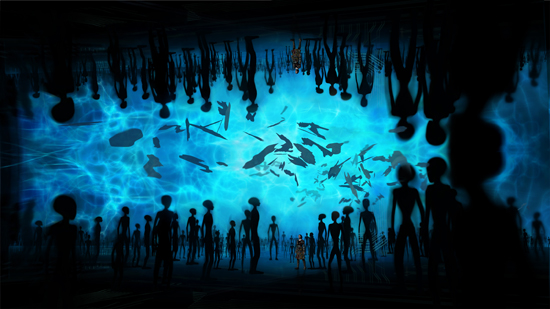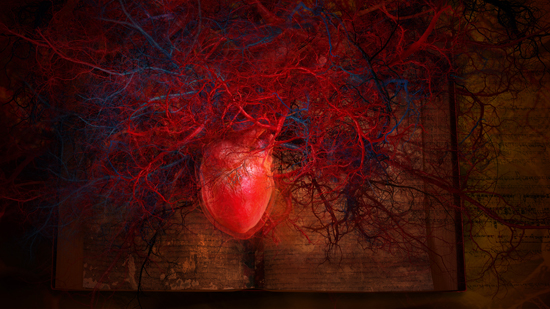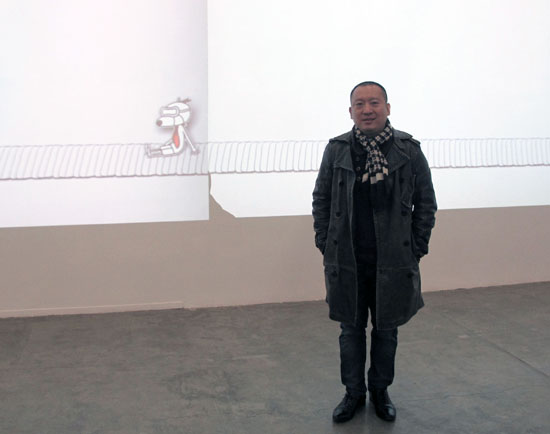Earlier this month, Zhang Xiaotao spoke to Luise Guest in Beijing about the importance of a revival of spirituality…
Visitors to Sydney’s White Rabbit Gallery are likely to have encountered Zhang Xiaotao’s paintings of rotting garbage, swarming ants and used condoms. Depicted with meticulous realism, and with such a fabulous palette of viridian greens and lurid, glowing yellows and purples that they somehow make his abject and repellant subject matter appear beautiful, they are an indictment of a decadent society focused on obsessive consumption. Zhang has said that we live in an “age of lust” and in the past the major themes of his work were sex and death. Trained at the Sichuan Academy of Fine Arts, one of the powerhouses of Chinese art education, he has reinvented himself as a new media artist of extraordinary ambition, using the new possibilities of 3D animation software to create allegories of our time on a dramatic scale. Zhang Xiaotao co-founded and now heads the Sichuan Fine Arts Academy’s New Media Studies Department. And in an equally dramatic shift, he has turned from a darkly satirical skewering of modern desires to a deep engagement with Buddhist theory and practice.
Zhang Xiaotao, The Adventures of Liang Liang, Animation, 11’49”, 2013. Image courtesy the artist and Pékin Fine Arts
For the China National Pavilion at the 2013 Venice Biennale, uber-curator Wang Chunchen selected two of Zhang’s 3D animations. I met the artist in Beijing during his solo show at Pékin Fine Arts and we talked about the dramatic developments in his life and art. “Zhang Xiaotao: In the realm of Microcosmic” presents three full-length video animation works. Sakya is centred upon the reconstruction of an important Buddhist temple in Tibet, partially destroyed by the Red Guards during the Cultural Revolution. Zhang has blended traditional Buddhist thangka painting and mandalas with live action film, video gaming imagery and lushly layered effects to produce a hypnotically beautiful and immersive experience. The Adventures of Liang Liang animates the charmingly eccentric drawings of the artist’s little son, creating an allegorical journey through heaven and hell blending traditional Chinese classical imagery of mountains and water with the contemporary world of traffic jams and airport security checks. Three Thousand Words attempts to visually represent the Buddhist notion of the three realms of our existence, a multi-level, multi-spatial exploration of human heart and universe as one. Photographic still images in the exhibition reinforce the themes found in all elements of Zhang’s practice.
Zhang Xiaotao, Sakya No.4, Still Image, 80x144cm, Edition10 2010-2011, image courtesy the artist and Pékin Fine Arts
I watched each animation with the artist, while he provided a commentary about his thinking. They draw inspiration from the contemporary visual language of video-gaming as much as from traditional Tibetan Buddhist iconography and the ancient Chinese tradition of ink painting. The Adventures of Liang Liang features cartoon characters, superheroes, and Buddhist deities in a joyfully eccentric visual cacophony. Characters ranging from Snoopy (in the red scarf of a Chinese “young pioneer) to cartoon monsters and the protagonists of traditional Chinese stories merge and overlap. It is wonderfully charming and thought provoking – and I for one totally get the analogy between airport security and the realms of the damned. Zhang is influenced by new theories in quantum physics and the way they challenge accepted notions of time and space and by the philosophies of Xu Bing, his mentor, and the artist he most admires. Zhang Xiaotao believes an artist should be “like an alchemist.” Over many cups of fragrant tea, I asked Zhang to tell me about his metamorphosis since 2005 from painter to new media artist working at the cutting edge of technology. What follows is an extract from a longer conversation, which took place in Chinese with an interpreter assisting.
ZX: In my view, we are now in an age of images, internet and technology. So we must learn new techniques and new languages. New media has changed my destiny. My work went to the Venice Biennale and the Asia Pacific Triennial in Queensland. I think it is an artist’s calling to study and implement new techniques and new languages. An artist must continue to learn and to transform. He has to do this every day. But I still paint! I like traditional material as well as new visual languages. So I spend half the time painting, half the time doing animation.
LG: So I wonder then, are your practice of painting and your practice of new media connected with each other or do you see them as separate and distinct elements of your work?
ZX: They are connected in terms of concept and philosophy. But I have a team, a studio, a lot of assistants. This is important. Making new media or animation requires a team. There’s a heavy work load in it…No matter how an artist expresses himself, whether in a two-dimensional or three-dimensional way, or a digital way, it is not the method or the technology that is the most important thing. What matters is how you turn your idea and thinking into language, how you share the language with others and make others feel interested, and whether what you create is innovative. So I think they are connected [in that way].
LG: Painting and animation are very different visual languages. Do you find it pleasurable to get back into the studio and paint, which is a very solitary activity, compared to the teamwork of the animation studio?
ZX: Doing animation is a lot more difficult. It involves time, money, knowledge and energy, especially when it comes to management. For example, if I have 20 assistants, I have to pay them every month. These are all very realistic problem. It takes one to two years to finish a film. It’s totally like the Long March! [Here Zhang is referring to the 10,000 kilometre trek of Mao’s army in 1934 – 1935, in which they crossed 18 mountain ranges and 24 rivers before reaching their new stronghold in Yan’an.] As for painting, it gives me pleasure, it’s an enjoyable process. Making animations is painful! But when you finish an animation, you feel happy as well. They are different to me, like my left hand and right hand, like two sides of a coin.
LG: We just saw your work ‘Sakya’ inspired by a famous temple in Tibet. You told the New York Times that your Utopia would be to see China in the middle of a Buddhist renaissance. Do you believe that China today has lost its way, and that people are seeking meaning in empty pursuits, in consumerism and materialism?
ZX: Modernisation and globalisation in the 20th Century gradually destroyed Chinese tradition. So I think we should re-discover our traditions and our religion, especially now that China has become more powerful economically, militarily and politically. Otherwise, just crazily making great strides will have horrifying consequences. After the establishment of the People’s Republic of China, domestic political factors like the Cultural Revolution were the main causes of the destruction of tradition. But today the harm inflicted by economic growth and business on Chinese culture, education and society are equally as serious as political issues. I think business is as damaging as politics. This is the reason I advocate that we turn to religion, and educate our children to go back to the origin of our culture. Also, the changes brought about by a market economy and globalisation can destroy our tradition and culture more [than politics].
LG: Did the birth of your son ten years ago make you think about these ideas much more deeply, thinking about the future of your child and all our children?
ZX: This is a good question. Since I’m a college teacher, I must have some conscience.
My attitude towards my students and my family is similar. Being the director of the New Media Department is the same. As the director, I want to improve this area of study for my students. This is all that I can do. I can’t change my country, but I can change little things around me like my school, my department and my family. To improve society, I want to begin with a cell, a drop of water.
LG: In this complicated 21st century world, what do you think is the function of art and the role of artist?
ZX: In today’s global economy that has changed the world, the identity of the artist has become more and more vague. I regard artists as the alchemists of this era. And like social sculpture, I hope that artists can get involved in helping to shape society. I hope artists can be the wizards in the lab of the future! I want practice and social action. It is important to change society in this way, because a globalised art market will erase the identity of artists and turn us into commodities. I don’t like that… I want artists to be change-makers or revolutionaries. An artist should not become the slave of commerce. He should change his world, getting involved in his society. This is the most important thing.
LG: So are you saying that artists in your opinion should be activists, that art can bring about social change?
ZX: Of course. I’ll give you an example. In 2008 and 2009, the Beijing government intended to demolish artists’ studios. I led a team and friends in our Art Zone and we took action to protect our studios and our community. We held on for five or six years. This is my true civic participation in this society. We petitioned, went to the media, held seminars and exhibitions. We managed to change the governmental plan for this art zone in Beijing. I am a teacher, I established the New Media Department and this too is a kind of social practice. So artists are like the bridge between art and society.
Zhang Xiaotao, Sakya No.5, Still Image, 80x144cm. Edition10 2010-2011, image courtesy the artist and Pékin Fine Arts
LG: In your most recent work, ‘Three Thousand Worlds’, again you are looking at Buddhism, and some very complicated ideas about quantum physics and the relationship between macroscopic and microscopic views of the universe. How do you reconcile traditional Buddhist beliefs with the demands of life in the 21st century?
ZX: In ancient Chinese culture, there is a Buddhist saying that “You can see a world by observing a flower.” It means the universe is included in very little things. That is a Buddhist thought. You can see the whole world from a pinhole and all ages from the tip of bamboo shoot. These are all traditional ideas in Chinese philosophy. They tell us that human hearts and the universe are connected. So I can put it this way. The crude philosophy of Chinese ancients and today’s science are connected as well. For example, quantum physics has proved that sections of human cells are strikingly similar to the surface of the moon. This phenomenon tells us that all things have spirits. Any single cell is one with the universe. For example, scientists have shown that the structure of a section of human brain corresponds to the structure of celestial bodies in space. Therefore, science and Buddhism are related. So I think we need to find a new code, a new language in their overlap. We have ancient times on the one hand, and the modern era in the other. You can find new things from where the two overlap. I show the meeting of sperm and egg at the end of Three Thousand Worlds, making it like a boundless universe. The human body is like a huge computer, a huge universe with all the data and information…Actually the ancient Chinese knew this a long time ago.
Zhang Xiaotao with his work ‘The Adventures of Liang Liang’ at Pékin Fine Arts, Beijing, December 2014, Photograph Luise Guest.
LG: As the director of the Sichuan Fine Arts Academy New Media Department, what do you think are the strengths and weaknesses of art education in China, as distinct from the West?
ZX: I think Chinese education now faces quite serious problems. The problems lie in social values in China. Everybody worships money. Idealists [among the students] are very few. Most students are shortsighted…This problem is not just about art but about the whole society. When we deal with education, the biggest issue is the utilitarianism and materialism of the whole society, the focus on commerce. Students do not learn for knowledge, happiness and belief. This is the biggest problem in my view. We learned new media from the West. But I value more the study and research on tradition like the history of Buddhist art, or social reforms in China. I think Chinese culture and Western new media should be combined in the artistic creation. Otherwise, we just learnt a language from the West, and what we create would lack our own concept and methodology. So when we teach our top students, we urge them to study Western technology and language abut also to think about China’s own problems. Merging these two elements is a new path. This is a choice we have to make when China faces globalisation and modernity. We have to come back to China, and return to examine our own culture and problems.
LG: Do you see yourself as essentially a Chinese artist, or do you believe that all artists today are global creatures who speak an international language?
ZX: I believe art language can be global. But at the core, the philosophy and methodology [in different places] are essentially different. Because things like new technology and new media can be globalised [in the production of artworks] but the thoughts behind them are different. It’s just like football is a global sport. But football in different regions has its own culture and philosophy. Football culture in Argentina, Australia, Germany or England is all different. So I think there is a global art market but not a globalised culture. I’d rather be a Chinese local artist. Whether Chinese art is or can be globalised, whether it can be shared by the world, is another question. The most important thing is to set out from China, from Chinese culture. If you don’t express your own problems, all that you present will be false. The most important thing is to go back to the origins of your culture and to go back to your own problem – to go back to China. You have to have roots, like a tree. Roots are here. To grow branches and leaves is another issue.
Zhang Xiaotao, ‘In the Realm of Microcosmic’ at Pékin Fine Arts Beijing till February 14 2015.





If you miss Zhang Xiaotao’s video animation works here in Beijing, his work will also be included in March in Art Basel Hong Kong’s Film Sector.